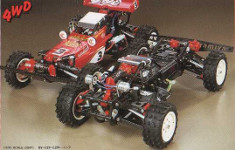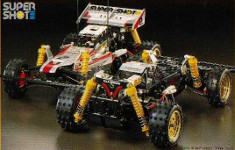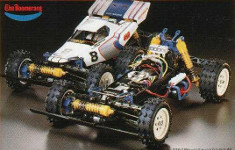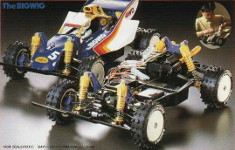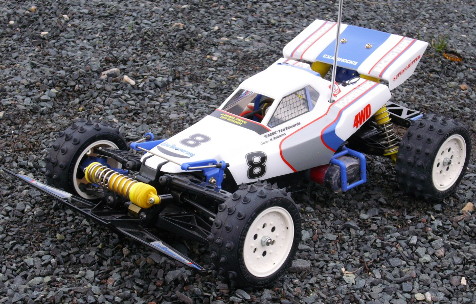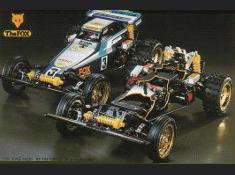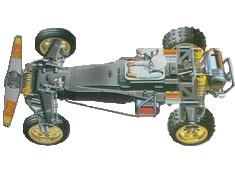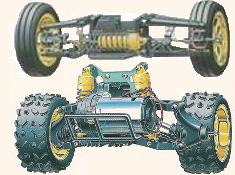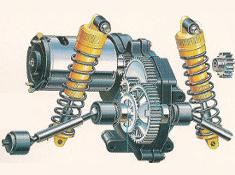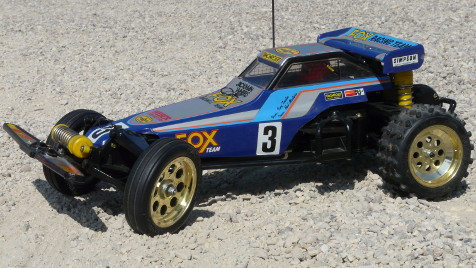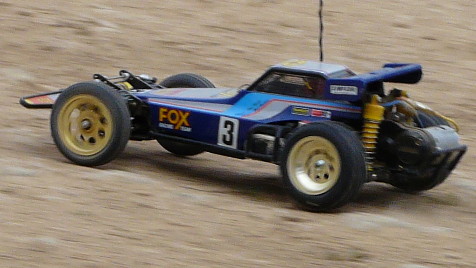The Hotshot platform
Back to 1985 when Tamiya released the Hotshot. Here too, the name I gave to the platform is neither official or the name given by fans: I needed to name it so I chose the first model name. However, this platform is very important too for Tamiya because it is their first ever 4WD buggy series and the models will actively participate to the buggy craze in the 80's.
The first generation was offered with 3 suspension variants:
- 1 damper per drivetrain
- 1 front damper and 2 rear dampers
- 2 dampers per drivetrain
Hotshot chassis
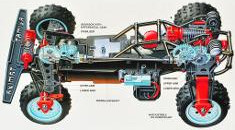
Supershot chassis
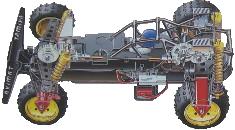
Boomerang chassis
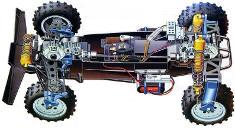
Bigwig chassis
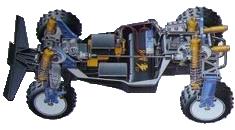
Hotshot drivetrains
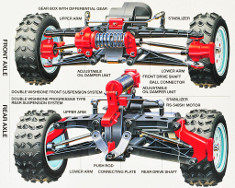
Supershot drivetrains
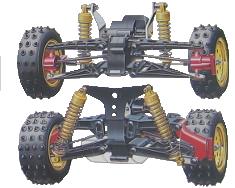
Boomerang drivetrains
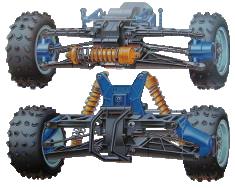
Bigwig drivetrains
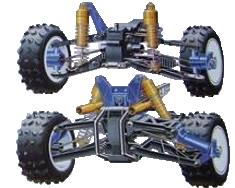
58047 Hotshot
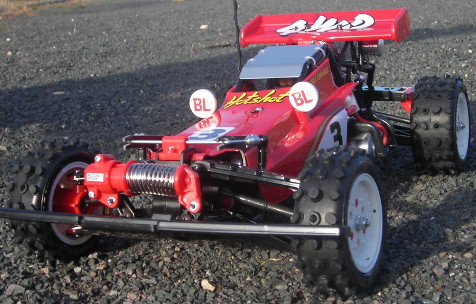
Promotional video of the Hotshot (© Tamiya)
Promotional video of the Bigwig (© Tamiya)
To properly understand the 1985 Hotshot, you need to replace it in the period context: at the time, there are very few 4WD electric buggies on the market. In fact, there is basically one, Kyosho's Progress 4WDS that was release in 1984:
Kyosho Progress 4WDS (1984) (© Kyosho)
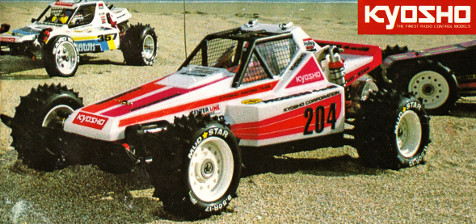
Kyosho Optima (1985) (© Kyosho)
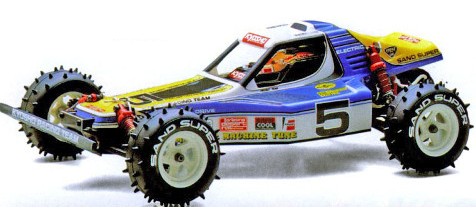
The Progress 4WDS is Kyosho's first 4WD electric buggy, and to my knowledge, the first on the market: chain-driven, 4 wheel-drive and steering, one unique damper on the front drivetrain, trailing arms at the rear. The Progress 4WDS will be followed by the Gallop (still in 1984) that improved several aspects keeping the same overall characteristics.
When the Hotshot is released at the beginning of 1985, it outperforms Kyosho's existing models. However, the overall chassis design was not meant to make a racer out of it: the central bathtub is a great protection for electronic (like the SRB's before), but the drawback is a rather complex accessibility to electronics inside, especially the receiver quartz. In addition, there are no real 4WD buggy category existing yet. Anyway, the release of Kyosho's Optima (presumably second half of 1985) will definitely seal the Hotshot potential at serious racing: good bye the 4 wheel steering, the rear trailing arms and the unique front damper as seen previously on the Progress 4WDS and the Gallop. From its release, the very modern Optima design immediately turns it into the reference and the preferred chassis for serious racing, before other competitors massively join the category.
One model of the series is special, apart from its... futuristic look: the Bigwig is the model celebrating Tamiya's 10 year Anniversary in radio-controlled cars. The bodyshell was designed by Takuya Yura, a famous real-size racing car bodyshell designer at the time. The chassis also includes some unique aspects: the battery tray was made bigger for 8.4v battery packs and it was equipped with the famous RX540VZ Technigold motor.
The Hotshot chassis design will also be used to create a new 2WD buggy that Tamiya will offer as a more sophisticated alternative to the Grasshopper series offering:
Promotional video of the Fox (© Tamiya)
My Fox in action
The Fox is the unique model using this Hotshot variant: not because it sold badly but probably because the biggest demand in 2WD buggies was either on the entry-level Grasshopper series or the racing scene with the RC10 by Associated. In addition, for the price of a Tamiya Fox, you could buy a 4WD buggy like the Boomerang: the vast majority of people would prefer 4WD.
A digression about the famous yellow hydraulic dampers the Fox introduced in 1985: they were not the first constant oil-bath damper on the market, but they were the very first efficient, reliable, non-leaking and affordable units available. In fact, their overall design has not much been modified over time, proving the original design was excellent. However, there are two versions of these famous “yellow” units:
- the first Fox production run
- the updated version that will equip the majority of Foxes and any other upcoming model up to now, whatever their color
The first version
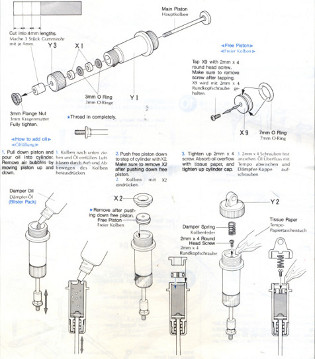
The most common version
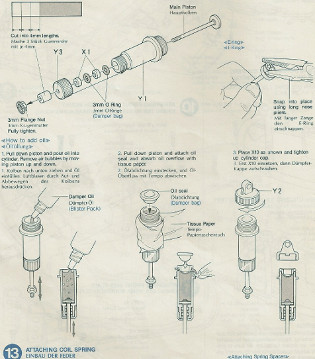
Current version (50520)
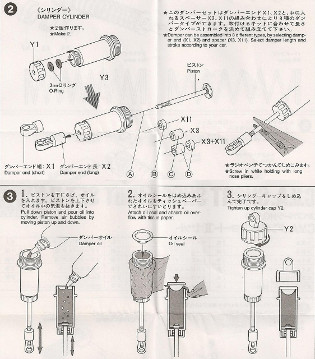
The difference between the very first batch (lasting a few months in production) and the most common one is located at the top of the damper piston rod. The first version has a free piston rod and a spring to let the oil volume move when the damper works. The evolution replaces this system with a rubber oil seal to perform the same function, probably with improved flexibility and efficiency. The current generation first seen on the 58068 Lotus Honda 99T model in 1987 (still yellow at the time) mainly improved the sealing washers at the bottom of the damper cylinder, but also separated the lower rod end / lower spring stay in two different parts (an olive-shape of C-shape spring base plus a rod end). The latter improvement allows to choose the length of the damper rod lower end, making the overall damper length vary a few millimeters more or less, so that the damper can suit a wider range of chassis needs.
As a last stand, Tamiya will re-use the Hotshot chassis design in 1987 for two last models: the first one is presented (and named) as the Hotshot version 2 and the second model is actually a re-bodied Boomerang.
58062 Hotshot II (1987)
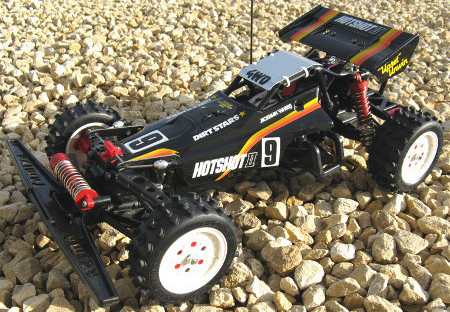
58066 Super Sabre (1987)
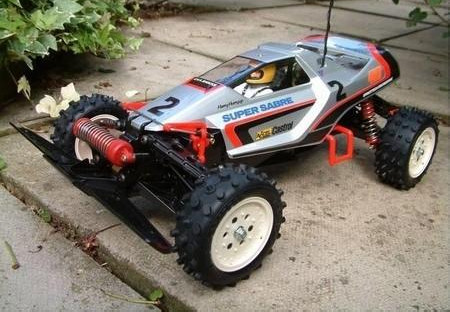
No doubt, the Hotshot II is an improved Hotshot: the complex suspension was simplified and now use the new Fox CVA dampers in a red version, and most importantly, a mobile panel grants easy access to electronics located into the chassis bathtub. At last, no more screwdriver required to dismantle half of the chassis just to change the receiver crystal. But the chassis handling remains about the same: in the end, this model will not sell very well and the late release will more or less turn it into the anonymous ghost of the series. As for the Super Sabre, it was released only one month before the second Hotshot chassis generation: why wasn't it released soon as an alternative to the Boomerang? No one knows but the model was definitely not remembered and did not sell well either.
By the end of 1987, Tamiya introduced the Hotshot platform second generation, here again with suspension variants : either one unique front damper or the classic two-damper configuration.
Thunder Shot chassis
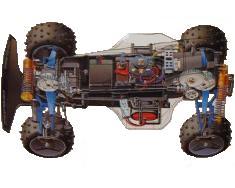
Thunder Shot drivetrains
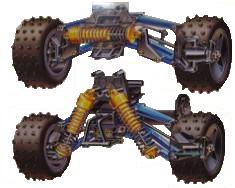
Terra Scorcher chassis
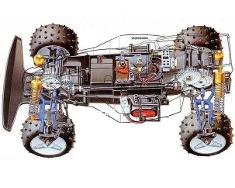
Terra Scorcher drivetrains
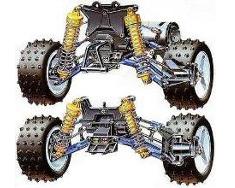
58067 Thunder Shot (1987)
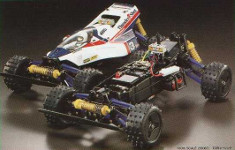
58073 Thunder Dragon (1988)
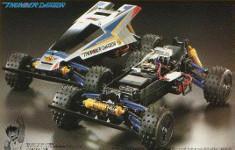
58075 Terra Scorcher (1988)
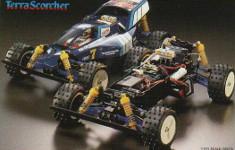
58078 Fire Dragon (1989)
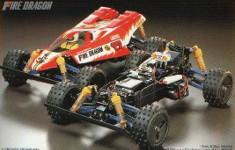
58067 Thunder Shot
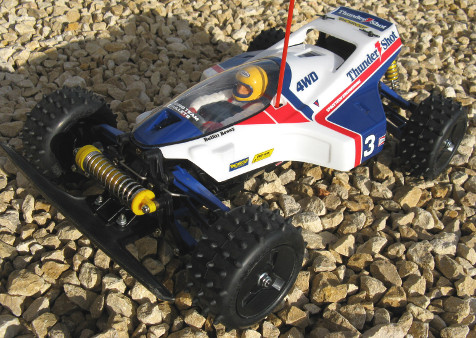
58078 Fire Dragon
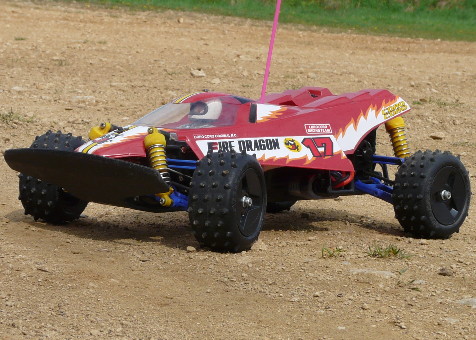
Promotional video of the Thunder Shot (© Tamiya)
Promotional video of the Terra Scorcher (© Tamiya)
The modifications on the second generation platform greatly improved the models performance, in particular at the front with a greater suspension travel and a softer suspension. However, this platform was still designed for leisure usage, Tamiya being secretly preparing very serious plans for the racing category.
At the time, the market is still in the buggy Golden Era period, so sales keep being very good for the new generation of buggies. Furthermore, Tamiya successfully offered two models with “dragon” bodyshells in response to the manga craze in Japan.
Conclusion on the Hotshot platform
The series starting with the Hotshot in 1985 was very successful for Tamiya: these 4WD buggies are mid-level products on the market, while the 2WD buggies of the Grasshopper series are the entry-level offer. In both segments, Tamiya dominates the market: Kyosho mainly focus on the higher level racing segment and Marui and Nichimo are pretty much the only manufacturers left to directly compete with Tamiya.
The second Hotshot platform generation will not bring anything really new: even though the models were interesting and sold well, it was somewhat obvious that Tamiya only performed a “lifting” on the old Hotshot platform. If you didn't know the up-coming Tamiya story, you would think Tamiya was resting on their laurels.
Related articles:




